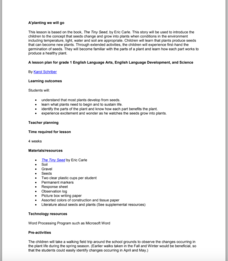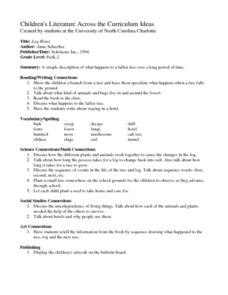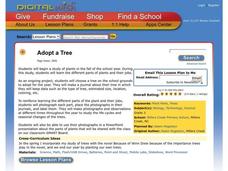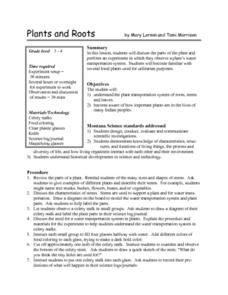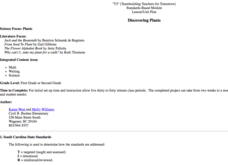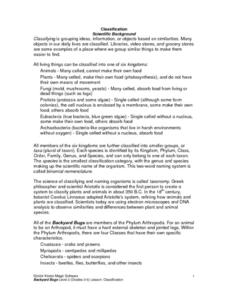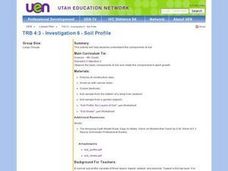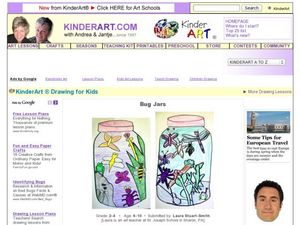Curated OER
A'planting We will Go
Germination is an amazing process that results in amazing things. The book The Tiny Seed is the inspiration for a set of activities that will help build early literacy, observation, language, and writing skills. The class observes how...
Curated OER
Harriman and Plant Identification
Students observe and record botanical details from the plant specimens. They identify plants using sorting key and field guide and classify specimens for preservation and display purposes.
Curated OER
Log Hotel
Pupils identify how the different plants and animals work together to cause the changes in the log. Students discuss the sequence of events in the life of the tree and log. Pupils plant a seed to take home and care for. Students retell...
Curated OER
The Great Pollinators
Students discover the reproductive parts of a plant. In this biology lesson, students identify and categorize several different plants they dissect in class. Students record their information using a data chart.
Curated OER
Adopt a Tree
Young scholars adopt tress on their school campus for scientific observation purposes. In this tree science lesson, students adopt a tree at their school, observe the season changes for the tree, and create a PowerPoint presentation...
Curated OER
Plant, Point and Record the Life Cycles of Plants
Students examine the life cycle of plants. Individually, they are given a digital camera in which they take pictures of plants in the various stages of the life cycle. To end the lesson, they plant their own flower bed in the classroom...
Curated OER
HFS-What do we have growing on the school grounds?
Students observe school grounds and take pictures of plants, trees, and bushes for identification. In this plant life lesson, students identify plants with the help of guides and resources.
Curated OER
the Naturalist's Notebook
Third graders, after brainstorming what they already know about trees and what effect the seasons have on them, create a model of a hollow log. They participate in a young naturalist's notebook writing activity while walking outside...
Curated OER
Just Bee-Tween Flowers!
Pupils examine the major plant and bee parts and the interdependency between bees and fast plants. They observe and record the stages of growth of fast plants, take photos of the plant's life cycle, and cross-pollinate plants.
Curated OER
How Does Your Garden Grow?
Students discover gardening by documenting plants grown on school grounds. In this botany instructional activity, students utilize digital cameras to capture images of plants on photo hikes which are turned into a slide show....
Curated OER
Terrarium Observation
Students observe the growth of plants in their terrarium. In this social studies lesson, students measure plant growth for several weeks. They predict what happens if other organisms are added in the terrarium.
Curated OER
Plants and Roots
Students discuss the parts of the plant and
perform an experiment in which they observe a plant's water
transportation system. They become familiar with
several local plants used for utilitarian purposes.
University of Southern California
Discovering Plants
Students construct a small greenhouse and plant lima beans. They read books about plants, tend the lima bean seedlings, observe and record plant growth, taste a variety of plants and maintain plant journals.
Curated OER
Environment: Mealworm Observations
Pupils observe plant and animal growth and participate in class discussions about the subjects. They also record their observations in a log. Using observation and the scientific method, they describe the characteristics of mealworms.
Curated OER
The Alphabet Garden
Third graders transplant, tend and observe a plant for each letter of the alphabet in a school garden. They work individually to research and select a plant that will grow in their local climate. Students then care for and observe the...
Curated OER
Photo Synthesis and Transpiration
Young scholars germinate pea seeds and plant the seeds. They experiment with different amounts of light and darkness on the plant growth.
Curated OER
Backyard Bugs
Explore the concept of scientific classification and the similarities and differences between plant and animal species. Your class will participate in hands-on activities by investigating dichotomous keys and classifying their shoes. To...
Curated OER
Sowing Seeds: the Beginning of the Fast Plant Life Cycle
Young scholars plant seeds, observe and tend plants. They identify major plant parts, how to germinate and troubleshoot problems with plants; and, that plants need water, light, and soil nutrients to thrive. They create a Plant Growth...
Curated OER
It's Challenging Being Green!
Young scholars influence the plant life cycle as they take care of plants.In this caring for plants lesson, students understand the parts of the plant and their functions in keeping it alive. Young scholars participate in experiments...
Curated OER
Urban Life: What Lives In Our Local Park?
Fifth graders participate in activities during a visit to Central Park. In this urban life lesson plan, 5th graders visit Central Park where they explore pond dipping, stream chemistry, and play a native plant Bingo game.
Curated OER
Investigation 6 - Soil Profile
Fourth graders study the components of soil. They observe the basic components of soil and relate the components to plant growth. They record color, texture, and kinds of materials on their profile log (light color, denser, grittier -...
Curated OER
Flowers, Pods, and Seeds
Students gain an understanding of living organisms. the complete a plant growth data log to chart plant growth and to make observations, predictions, and personal reflections.
Alabama Learning Exchange
Botany Scavenger Hunt Where's the Ginkgo?
Learners use a science journal to log plants that are native to Alabama. In this plant lesson plan, students identify characteristics, describe environments, and classify the plants that they find.
Curated OER
Bug Jars
Young scholars explore symmetry. Students observe a variety of bug and plant drawings, then draw a bug jar. Young scholars observe bugs from the top of the jar for a symmetrical view, and the side of the jar for an asymmetrical...
